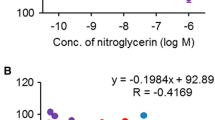Abstract
Aims: To test the hypothesis that ketanserin augments coronary collateral blood flow and decreases myocardial ischemia during balloon angioplasty. Methods and Results: Forty-four patients with single vessel disease and stable angina were studied. Collateral flow was determined during balloon inflations, based on the distal velocity time integral (13 patients) or on coronary wedge/mean arterial pressure measurements (10 patients). The 2nd and 3rd inflations lasted the same time and between them 1.5 mg intracoronary ketanserin in 10 ml normal saline was administered over 3 min. In 21 control subjects normal saline alone was given. In the flow velocity group the velocity time integral was 78.5 ± 53.1 mm during the 2nd inflation and 106.0 ± 43.2 mm during the 3rd (p < .05), while the ST deviation was 1.1 ± .7 and .7 ± .7 mm, respectively (p. < .05). In the intracoronary pressure group the CWP/MBP was .40 ± .10 during the 2nd inflation and .45 ± .11 during the 3rd (p. < .05), while the ST deviation was 1.2 ± .8 and .8 ± .8 mm respectively (p. < .05). In the controls no variables changed during the tested inflations. Conclusion: Intracoronary administration of ketanserin augments coronary collateral flow and decreases myocardial ischemia during balloon angioplasty. This could be of clinical significance in the management of acute ischemic syndromes.
Similar content being viewed by others
References
Golino P, Piscione F, Willerson JT, et al. Divergent effects of serotonin on coronary-artery dimensions and blood flow in patients with coronary atherosclerosis and control patients. N Engl J Med 1991;324:641–648.
Wright L, Homans DC, Laxson DD, Dai XZ, Bache RJ. Effect of serotonin and thromboxane A2 on blood flow through moderately well developed coronary collateral vessels. J Am Coll Cardiol 1992;19:687–693.
McFadden EP, Clarke JG, Davies GJ, Kaski JC, Haider AW, Masseri A. Effect of intracoronary serotonin on coronary vessels in patients with stable angina and patients with variant angina. N Engl J Med 1991;324:648–654.
Golino P, Piscione F, Benedict CR, et al. Local effect of serotonin released during coronary angioplasty. N Engl J Med 1994;330:523–528.
Doucette JW, Corl DP, Payne HP, et al. Validation of a Doppler guide wire for intravascular measurement of coronary artery flow velocity. Circulation 1992;85:1899–1911.
Donohue TJ, Kern MJ, Aguire FV, Bell C, Penick D, Ofili E. Comparison of hemodynamic and pharmacologic pertubations of coronary collateral flow velocity in patients during angioplasty. J Am Coll Cardiol 1992;19:383A.
Yamada T, Okamoto M, Sueda T, Hashimoto M, Kajiyama G. Relation between collateral flow assessed by Doppler guide wire and angiographic collateral grades. Am Heart J 1995;130:32–37.
Pijls NHJ, Van Son JAM, Kirkeeide RL, De Bruyne B, Gould KL. Experimental basis of determining maximum coronary, myocardial, and collateral blood flow by pressure measurements for assessing functional stenosis severity before and after percutaneous transluminal coronary angioplasty. Circulation 1993;86:1354–1367.
Pijls NHJ, De Bruyne B. Assessment of collateral blood flow by coronary pressure measurement, In: Coronary Pressure. London: Kluwer Academic Publishers, 1997: 237–259.
Rentrop KP, Cohen M, Blanke H, Phillips RA. Changes in collateral channel filling immediately after controlled coronary artery occlusion by an angioplasty balloon in human subjects. J Am Coll Cardiol 1985;5:587–592.
Uehata A, Matsuguchi T, Bittl JA, et al. Accuracy of electronic digital calipers compared with quantitative angiography in measuring coronary arterial diameter. Circulation 1993;88:724–729
Quigley PJ, Hinohara T, Phillips HR, et al. Myocardial protection during coronary angioplasty with an autoperfusion balloon catheter in humans. Circulation 1988;78:1128–1134.
Kaltenbach M, Beyer J, Walter S, Klepzig H, Schmidts L. Prolonged application of pressure in transluminal coronary angioplasty. Cathet Cardiovasc Diagn 1984;10:213–219.
Cribier A, Korsatz L, Koning R, et al. Improved myocardial ischemic response and enhanced collateral circulation with long repetitive coronary occlusion during angioplasty: A prospective study. J Am Coll Cardiol 1992;20:578–586.
Kloner RA, Yellon D. Does ischemic preconditioning occur in patients? J Am Coll Cardiol 1994;24:1133–1142.
Perry RA, Seth A, Hunt A, et al. Balloon occlusion during coronary angioplasty as a model of myocardial ischaemia: Reproducibility of sequential inflations. Eur Heart J 1989;10:791–800.
Schaub RG, Meyers KM, Sande R. Serotonin as a factor in depression of collateral blood flow following experimental arterial thrombosis. J Lab Clin Med 1977;90:645–653.
Verheyen A, Vlaminckx E, Lauwers F, VanDen Broeck C, Wouters L. Serotonin-induced blood flow changes in the rat hindlegs after unilateral ligation of the femoral artery. Inhibition by the S2 receptor antagonist ketanserin. Arch Int Pharmacodyn Ther 1984;270:280–298.
Nevelsteen A, DeClark F, Loots W, De Gryse A. Restoration of post-thrombotic peripheral collateral circulation in the cat by ketanserin, a selective 5-HT2 receptor antagonist. Arch Int Pharmacodyn Ther 1984;270:268–279.
Hollenberg NK. Collateral arterial tree responses to serotonin. J Cardiovasc Pharmacol 1987;10(Suppl 3):S35–S38.
McFadden EP, Bauters C, Lablanche JM, Quandalle P, Leroy F, Bertrand ME. Response of human coronary arteries to serotonin after injury by coronary angioplasty. Circulation 1993;88:2076–2085.
De Cree J, Leempoels J, Geukens H, Verhaegen H. Comparison of blood pressure ration by Doppler velocimetry and by plethesmography during treatment with ketanserin, a 5-HT2 receptor antagonist: A measure of improved collateral and microcirculatory flow. J Cardiovasc Pharmacol 1985;7(Suppl 7):S92–S94.
Adams GA, Feuerstein IA. Platelet accumulation on collagen drugs which inhibit arachidonic acid metabolism and affect intracellular cyclic AMP levels. Thromb Haemost 1984;52:45–49.
Tanaka T, Fujita M, Nakae I, et al. Improvement of exercise capacity by sarpogrelate as a result of augmented collateral circulation in patients with effort angina. J Am Coll Cardiol 1998;32:1982–1986.
Robertson JI, Stott DJ, Ball SG. Antihypertensive mode of action of ketanserin. J Cardiovasc Pharmacol 1987;10:S45–S47.
Author information
Authors and Affiliations
Rights and permissions
About this article
Cite this article
Kyriakides, Z.S., Sbarouni, E., Nikolaou, N. et al. Intracoronary Ketanserin Augments Coronary Collateral Blood Flow and Decreases Myocardial Ischemia During Balloon Angioplasty. Cardiovasc Drugs Ther 13, 415–422 (1999). https://doi.org/10.1023/A:1007851906207
Issue Date:
DOI: https://doi.org/10.1023/A:1007851906207




